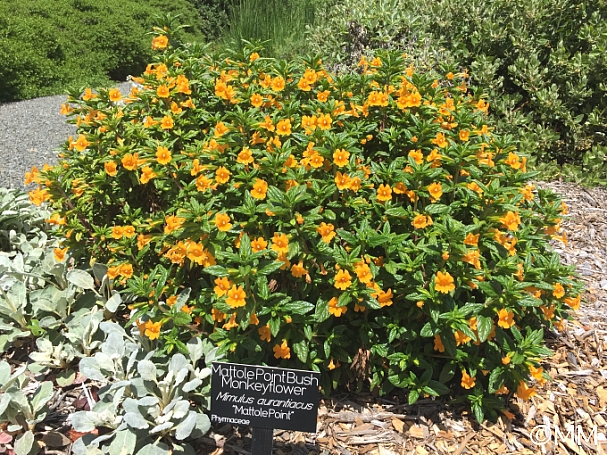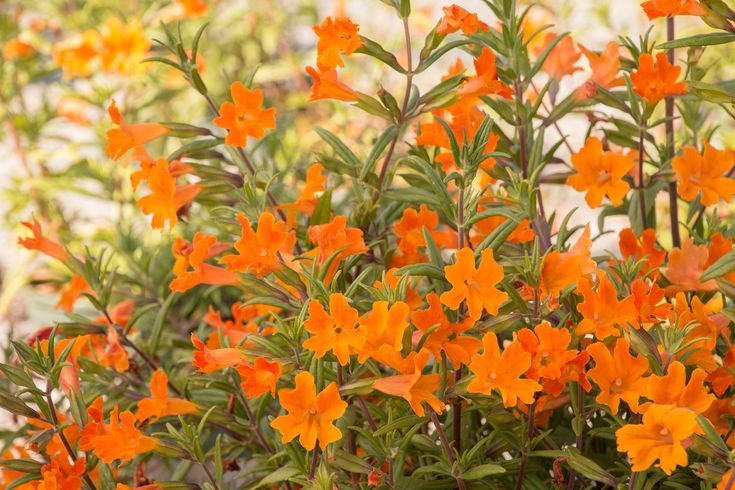Mimulus aurantiacus

Mimulus aurantiacus, commonly known as Sticky Monkeyflower, is a charming perennial shrub native to the western United States.
Renowned for its showy orange, red, or yellow flowers and attractive foliage, Sticky Monkeyflower adds a splash of color and diversity to a variety of habitats.
In this comprehensive article, we will delve into the botanical intricacies, habitat preferences, life cycle, ecological and cultural importance, conservation status, and care guidelines for Mimulus aurantiacus.
Botanical Description
Mimulus aurantiacus is a compact, evergreen shrub that typically reaches heights of 1 to 3 feet tall and wide.
It features lance-shaped leaves with slightly sticky surfaces, which give rise to its common name.
The flowers of Sticky Monkeyflower are its most distinctive feature, occurring in clusters at the ends of branches.
These tubular-shaped flowers come in a range of colors, including shades of orange, red, yellow, and occasionally pink.
The flowers are characterized by two lips, with the lower lip often serving as a landing pad for pollinators.
Sticky Monkeyflower blooms from late spring to early summer, attracting a variety of pollinators, including bees, butterflies, and hummingbirds.
Habitat and Distribution
Mimulus aurantiacus is native to a wide range of habitats, including chaparral, coastal sage scrub, oak woodlands, and riparian areas.
It is found throughout California and extends into parts of Oregon, Nevada, and Baja California.
Sticky Monkeyflower thrives in well-drained soils and partial to full sunlight but can tolerate a variety of soil types and light conditions.
It is commonly found growing along stream banks, in rocky outcrops, and on slopes, where it contributes to soil stabilization and erosion control.
Life Cycle and Phenology
As a perennial shrub, Sticky Monkeyflower exhibits a relatively long life cycle compared to annual plants.
Growth typically occurs in spring and early summer, with new leaves and flowers emerging from dormant buds as temperatures rise and day length increases.
Flowering peaks in late spring to early summer, depending on local climate conditions, with individual flowers lasting several days to a week.
After flowering, Sticky Monkeyflower may produce small, capsule-like fruits containing numerous tiny seeds.
These seeds are dispersed by gravity, wind, water, and animals, contributing to the plant's reproductive success and dispersal.
Ecological and Cultural Importance
Sticky Monkeyflower plays a significant ecological role in its native habitat, providing food and habitat for a variety of wildlife species.
The flowers are a valuable nectar source for bees, butterflies, and hummingbirds, supporting pollinator populations and promoting biodiversity.
Additionally, the foliage provides cover and nesting sites for small mammals, birds, and insects.
Culturally, Sticky Monkeyflower has been used by indigenous peoples for medicinal purposes, as well as for ceremonial and decorative uses.
In gardens and landscapes, Sticky Monkeyflower may be valued for its vibrant flowers, attractive foliage, and ability to attract pollinators.
Conservation and Threats
Although Sticky Monkeyflower isn't presently on the endangered list, it encounters conservation challenges from habitat loss, urbanization, and invasive species.
The expansion of urban areas, agriculture, and infrastructure development has led to the fragmentation and degradation of native habitats where Sticky Monkeyflower once thrived.
Invasive plant species, altered fire regimes, and climate-related factors further exacerbate these threats, affecting the distribution and abundance of native plant species throughout the western United States.
Conservation efforts focused on habitat preservation, restoration, and public education are essential for ensuring the long-term survival of Sticky Monkeyflower and other native plants in the region.

Caring for Mimulus aurantiacus
Sunlight
Plant Sticky Monkeyflower in a location that receives partial to full sunlight, as it prefers abundant sunlight for optimal growth and flowering.
Watering
Water young plants regularly during the first growing season to establish a strong root system.
Once established, Sticky Monkeyflower is drought tolerant and generally requires minimal irrigation.
Water deeply during prolonged dry spells, especially in inland areas.
Soil
Plant in well-drained, sandy or loamy soil with good drainage.
Sticky Monkeyflower is adaptable to a variety of soil types but prefers soil with good drainage.
Avoid heavy clay soils, which can cause root rot and other problems.
Pruning
Prune Sticky Monkeyflower lightly after flowering to maintain a compact, bushy shape and remove any dead or leggy growth.
Avoid heavy pruning, as this can reduce flowering and overall plant vigor.
Fertilizing
Sticky Monkeyflower generally does not require fertilization, especially in nutrient-rich soils.
But if you think it is necessary, apply a balanced fertilizer in spring, following the manufacturer's instructions.
Mulching
Apply a layer of organic mulch around the base of the plant to help retain moisture, suppress weeds, and insulate the roots from temperature fluctuations.
Avoid placing mulch directly against the stem to prevent rot and fungal diseases.
By adhering to these care instructions, you can foster thriving Sticky Monkeyflower shrubs, aiding in native plant conservation and enhancing landscapes.
Whether for ecological, cultural, or ornamental purposes, Sticky Monkeyflower's vibrant blooms and resilience are captivating.
Leave a Reply
You must be logged in to post a comment.